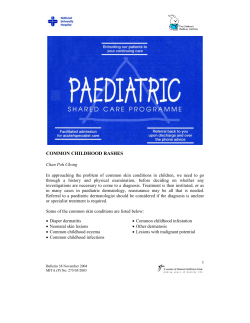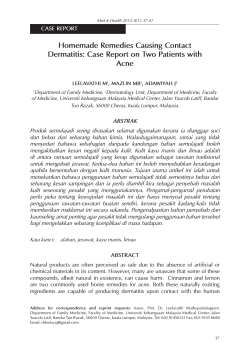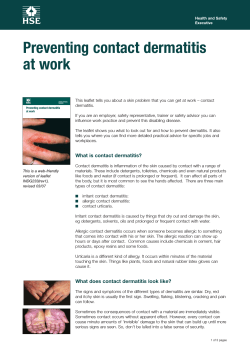
Skin Lecture 4
Pathology of the
Integumentary System
Lecture 4
Parasitic / Immune
(web)
Paul Hanna
Apr 2015
PARASITIC SKIN DISEASES
• cause disease directly:
inflammation
blood sucking
toxin injection
results: annoyance
reduced production
unthrifty / blemished hides
• cause disease indirectly:
important vectors eg WNV, RMSF, Lyme, Leishmaniasis, dirofilariasis
predispose to pyoderma, myiasis or local viral infections
Diagnosis
• history & clinical signs (esp. pruritus) / lesions
• parasite ID
• skin biopsy
MITES
Demodectic Mange
• normal microfauna, neonates acquire from dam
• see mainly in dogs with genetic predisposition &/or immunodeficiency
Localized form
young dogs (3-10 months), usually self-limiting
1 to 5 patchy areas of alopecia; variable erythema, scaling & hyperpigmentation
Generalized form
in juveniles following localized form (~10%)
• in older dogs internal disease &/or immunosuppression
massive proliferation of mites folliculitis / furunculosis, 2o pyoderma
Localized Demodecosis
With localized demodecosis can see focal areas of alopecia,
erythema and/or hyperpigmentation, and comedones.
Generalized Demodecosis
Generalized demodecosis with secondary pyoderma, note widespread alopecia with scaling / crusting
Demodex mites from scrapings
Histopathology showing perifolliculitis with
demodex mites in follicular lumina.
Sarcoptic Mange (Scabies)
• pigs > dogs > ruminants, horses
• highly contagious, host-adapted varieties (eg. S. scabiei var. suis)
• zoonotic; humans readily parasitized, but usually limited reaction to animal varieties
• lesions due to:
mechanical damage from burrowing
irritation from mite saliva and excreta
hypersensitivity to mite products
Alopecia & excoriations
Alopecia, lichenification, hyperpigmentation
Marked crusting within ear canal of pig
Severe excoriations / crusting on a human hand due to
hypersensitivity reaction to an animal variety of mite.
Pruritic papules on human arm (above) which is a
typical skin reaction to animal mites
Mite tunneling within
cellular crust
Notoedric Mange
Cheyletiellosis
Otodectic Mange
Psoroptic Mange
Chorioptic Mange
Psorergatic Mange
Trombiculidiasis
Marked crusting and excoriation on face of cat with Notedric mange
TICKS
• divided into 2 families, ie hard ticks (Ixodidae) and soft ticks (Argasidae)
• vectors for many viral, rickettsial, bacterial & protozoal diseases
• can also cause local skin damage, anemia or paralysis
FLEAS
• most important cause of skin disease in small animals (C. felis & C. canis)
• can cause pruritus / irritation skin, anemia, infectious disease vectors, HS reactions
• clinically, can see:
asymptomatic carriers
flea-bite dermatitis
flea allergy dermatitis
Flea “dirt” (ie flea feces composed of dried digested blood), may be more readily found than the fleas themselves
LICE (PEDICULOSIS)
Sucking lice - feed on blood and tissue fluids
Biting lice - feed on exfoliated epithelium and debris
Many lice with numerous
eggs (nits) attached to
hairs.
FLIES
• cause : annoyance (“fly-worry”)
localized skin damage / pruritus (fly bite dermatitis)
+/- hypersensitivity (eg Culicoides HS)
anemia
direct toxicity (eg black fly toxin)
vectors for infectious agents
myiasis
vetgrad.co.uk
Feline Mosquito-bite dermatitis / hypersensitivity.
See characteristic crusted papules on the bridge of
the nose, pinnae and perauricular regions.
FIGURE 5-92 (Sm An Derm) Fly Bite Dermatitis. Alopecia
& crusting (hemorrhagic) on the ear tip of a dog. Note
the similarity to scabies and autoimmune skin disease.
FLIES
Black fly bite on glabrous skin of a dog’s abdomen. Some
animals show these characteristic annular lesion of a central
pale zone of edema, with peripheral erythematous rim
FLIES
Myiasis - infestation of living animals tissues with fly larvae (maggots / grubs)
Warbles (Hypoderma)
• primarily cattle, occasionally horses & others
• eggs laid on hair (esp legs) larva burrow into skin migrate & overwinter in
epidural fat or esophagus in spring migrate to subQ along back and form nodules
mature larvae emerge & pupate on soil
eg damaged hide due to warble fly larvae in subQ nodules along the back of cattle
FLIES
Myiasis - infestation of living animals tissues with fly larvae (maggots / grubs)
Cuterebriasis
• typically small wild mammals, but occasionally infest cats and others
FIGURE 5-84 (Sm An Derm Atlas) Cuterebra. Erythema and
fibrosis surround the breathing hole of the Cuterebra on the
neck of an adult cat. A purulent exudate is common.
FIGURE 5-85 (Sm An Derm Atlas) Cuterebra. The
Cuterebra has been removed with hemostats. The lesion
consists of a fibrosed tunnel with a purulent exudate.
HELMINTH DISEASE
Cutaneous larval migration
• adults live in non-cutaneous sites while larval stages migrate through skin
Cutaneous Habronemiasis (“summer sores”)
• due to aberrant deposition and migration of Habronemia & Draschia spp larvae
• normally larvae deposited near mouth swallowed develop in stomach wall
• when larvae deposited on moist skin / wounds by flies ulcerative dermatitis
note: ulcerated / nodular lesions on lip and periocular regions (r/o sarcoid, squamous cell carcinoma)
Ulcerated lesion on fetlock (above) and multiple ulcerated
papules and nodules involving the prepucial orifice and
urethral process (below - from Eq Derm 2nd ed)
On histologic examination there is typically eosinophilic
granulomatous inflammation, which often contain
segments of Habronema larva within areas of necrosis.
HELMINTH DISEASE
Filarial Dermatitis
adults or microfilaria spend some time in the skin
Onchocerciasis
Stephanofilariasis
Dirofilarial (heartworm) dermatitis
Equine cutaneous ochocerciasis.
Adults O. cervicalis live in nuchal
ligament and microfilaria in dermis.
The prevalence of infection is high in
North America, but most horses don’t
have lesions. There is strong evidence
that those horses that develop skin
lesions have individual (sporadic)
hypersensitivity to microfilarial
antigens. The characteristic lesions
are areas of alopecia, scaling / crusting
and leukoderma.
PROTOZOAL DISEASES
Sarcocystosis
Leishmaniasis
Besnoitiosis
Fig 6-25 Leishmaniasis. (Atlas Sm An Derm) Alopecia and crusting on the
nose and periocular skin of a Labrador. Note the mild nature of the lesions.
IMMUNE-MEDIATED SKIN DISEASE
HYPERSENSITIVITY REACTIONS
Definition
response to normally harmless foreign compounds (Ag’s)
most cutaneous HS's are mediated by types I or IV HS reactions
pruritus is a feature common to most HS's
HYPERSENSITIVITY REACTIONS
Diagnosis
• history and clinical signs (esp pruritus) / lesions
• skin biopsy (mostly non-diagnostic)
• intradermal skin testing, elimination of Ag’s, response to therapy
1. ATOPIC DERMATITIS
• common in dogs (genetic/familial); less in cats and horses
• variety of predominately transepidermally absorbed allergens (+/- seasonal)
• complex type I (+/- IV) HS to normally innocuous exogenous Ag's.
• possible dysfunction of Th2 cells with overproduction of specific IgE
• mast cell degranulation pruritus self-trauma
Gross
• pruritus self-trauma erythema, excoriation, alopecia (esp face / feet / abdomen)
hyperpigmentation & lichenification
Histology
• early perivascular / interstitial dermatitis
• later hyperplastic P/I dermatitis; often 2o pyoderma / Malasseziasis
Skin biopsy showing
edema of superfical
dermis and mild
perivascular /
interstitial infiltrate of
inflammatory cells
Differential Diagnosis
• histology non-diagnostic, R/O other allergies and ectoparasitism
2. FLEA ALLERGY DERMATITIS (Flea-bite Hypersensitivity)
most common hypersensitivity of cats and dogs, in flea endemic areas
combination of types I & IV HS to antigens in flea saliva
once sensitized, few fleas are needed for severe reaction
intense pruritus self trauma / secondary infections
Gross
primary lesion is an erythematous papule or wheal
self-trauma alopecia, excoriation & crusts
chronicity hyperpigmentation & lichenification
note: excoriation / crusts / early lichenification of
lateral thorax & lumbosacral area
note: alopecia / excoriations (above) and mostly just
alopecia due to excessive “grooming” (below)
Crusted papules of “miliary dermatitis”
(note millet seeds on bread in top pic)
Histology
• early perivascular / interstitial dermatitis with eosinophils & mast cells later
mononuclear cells
• may see spongiosis &/or eosinophilic microabscesses ("nibbles")
3. SOME OTHER HYPERSENSITIVITY REACTIONS
Urticaria (hives or wheals) / Angioedema (edematous swellings)
Allergic Contact Dermatitis [Contact HS]
Food Hypersensitivity (Food Allergy)
Equine Insect (Culicoides) Hypersensitivity
Etc.
SOME OTHER HYPERSENSITIVITY REACTIONS
Allergic Contact Dermatitis [Contact HS]
Occurs following prolonged contact (sensitization) with the offending
allergen (eg plants, cleaners, synthetic carpets plastic dishes, rubber
chew toys, etc). Early lesions of erythema, papules / plaques and
vesicles are seen in the areas of contact (esp sparsely haired regions).
AUTOIMMUNE REACTIONS
when autoAb’s or T cells react against self Ag’s
most have hereditary predisposition; rare in domestic animals (dogs > horses, cats)
Pemphigus
• autoAb’s to desmosomal Ag's (desmogleins) loss of cohesion & inflammatory
mediators acantholysis intraepidermal pustules with acantholytic cells
Acantholysis = loss of cohesion between keratinocytes
Pemphigus foliaceous
Immune staining of deposits of intracellular
autoimmune IgG in the upper epidermal region.
Subcorneal pustule with numerous acantholytic
cells admixed with neutrophils
Pemphigus foliaceus
The primary lesion is superficial pustules, but they are often obscured by
hair coat or have ruptured because they are very superficial and fragile.
Pemphigus foliaceous
Pemphigus foliaceous, dog Widespread alopecia, scaling, crusting
Thick crusts on footpads of dog with pemphigus
folicaceous. Crusts result from adherence of the
content of ruptured pustules to the skin surface
Pemphigus foliaceous
Numerous pustules & epidermal collarettes
Bullous pemphigoid
• autoantibodies against BPAg2 in hemidesmosome subepidermal vesicles/pustules
Subepidermal vesicle - complete separation of the intact
epidermis (including basal layer) from the dermis.
Bullous pemphigoid
grossly see vesicles / bullae which often rupture
to leave ulcers
Fig 8-45 (Atlas Sm An Derm) Bullous Pemphigoid.
Severe ulcerative dermatitis on the abdomen. The punctate
lesions coalesced to form large ulcerative lesions. Note the
similarity to erythema multiforme, cutaneous drug reactions,
and vasculitis.
Discoid (cutaneous) lupus erythematosus
• UV light alters keratinocyte Ag’s autoimmune reaction interface dermatitis
Interface dermatitis, with dense lichenoid band of lymphocytes & plasma cells, apoptotic basal keratinocytes (arrow) &
pigmentary incontinence
Discoid (cutaneous) lupus erythematosus
Note, alopecia, erythema, erosion / ulceration, crusting, &
depigmentation of nasal planum region.
Same dog following treatment; note resolution of
inflammation but depigmentation remains.
AUTOIMMUNE REACTIONS
Diagnosis
history and clinical signs / lesions
skin biopsy of fresh lesions
immunologic tests – esp IHC
SOME OTHER IMMUNE-MEDIATED DISORDERS
Immune-mediated Vasculitis
Erythema Multiforme
Toxic Epidermal Necrolysis
Vogt-Koyanagi-Harada-like syndrome
Plasma Cell Pododermatitis
Cutaneous Amyloidosis
Infarction of facial skin following
immune-mediated vasculitis
© Copyright 2025










